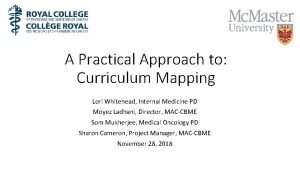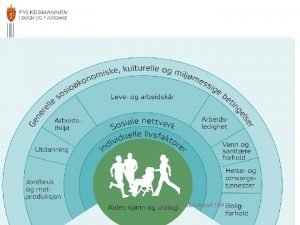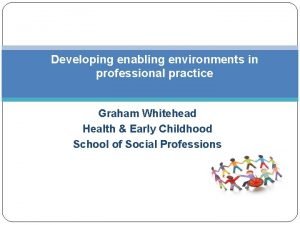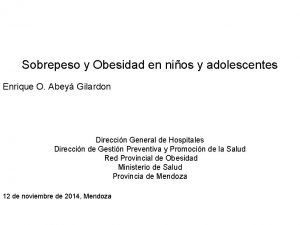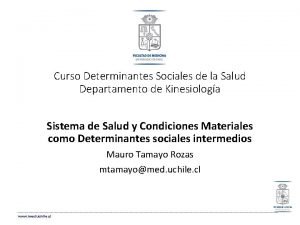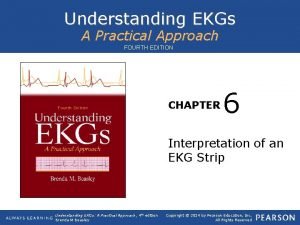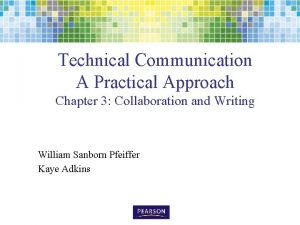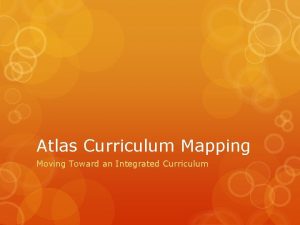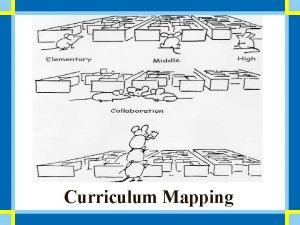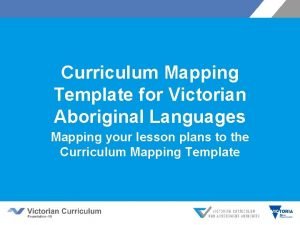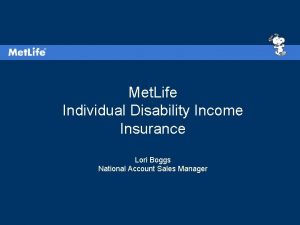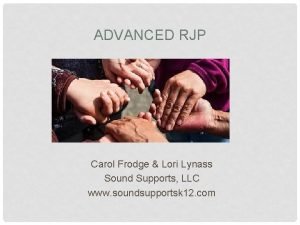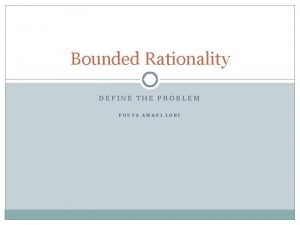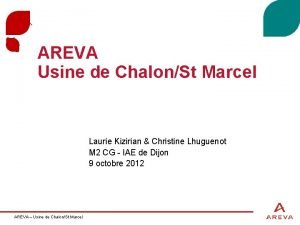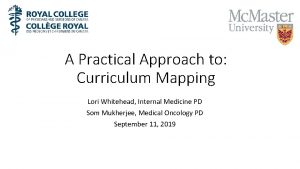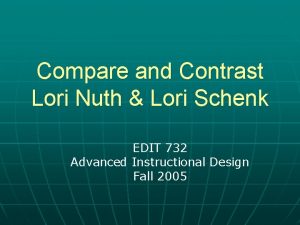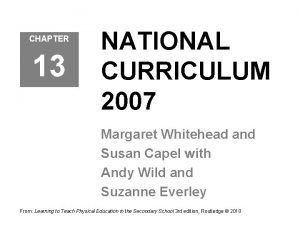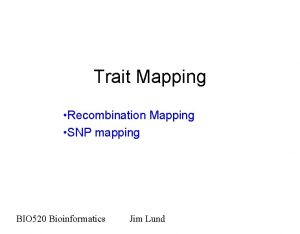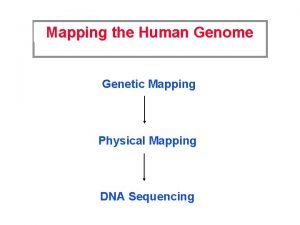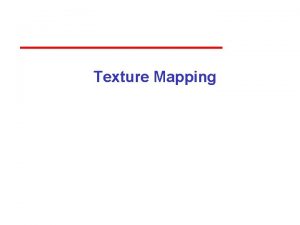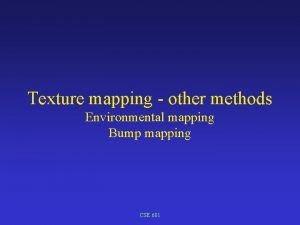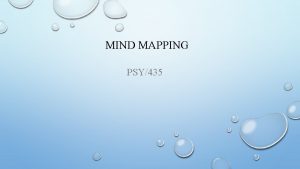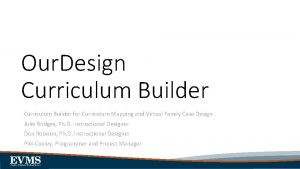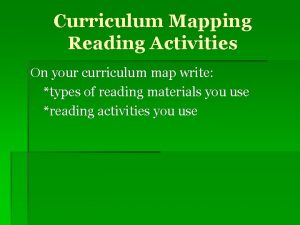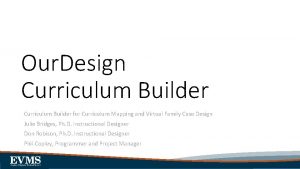A Practical Approach to Curriculum Mapping Lori Whitehead





































- Slides: 37

A Practical Approach to: Curriculum Mapping Lori Whitehead, Internal Medicine PD Moyez Ladhani, Director, MAC-CBME Som Mukherjee, Medical Oncology PD Sharon Cameron, Project Manager, MAC-CBME November 28, 2018

Objectives • During this evening’s presentation and workshop, we plan to cover the following areas: • 1) Why curriculum maps are an essential tool for CBD • 2) Demonstrate why basic foundational knowledge of curriculum mapping is helpful in preparing for the transition to CBD • 3) Illustrate the different types of curriculum maps • 4) How to choose which curriculum maps to use for your program • 5) How to integrate Can. MEDS 2015 to serve as foundation of curriculum map • 6) Develop your own curriculum maps for your specific residency training program using a 10 -step process from the Royal College

Format • Introduction • Workshop: Group Session 10 min 25 min • Workshop: PD activity with facilitator support 45 min • Group Activity 10 min • Review of template example documents • An overview of your program’s • Revised Royal College Suite – EPAs, Training Experiences • Existing training experiences, settings and assessment tools • Resources • Select template(s) that best suit the needs of your program • Start a curriculum map for your program • Debrief • Q&A

What is Curriculum Mapping?

Curriculum Mapping: Definition • Curriculum Mapping • ‘A visual representation of the curriculum as a sophisticated blend of educational strategies, course content, learning outcomes, educational experiences, assessment, the education environment and the individual students personal timetable and progress. ’ • R. M. HARDEN • Centre for Medical Education and Education Development Unit, Dundee, UK

Why Should I Develop One? • Benefits of a Curriculum Map • Indicates the relationships between various components of your residency program’s curriculum • Helps plan learning activities along CBD stages (including RTE’s) • Links the competencies to be mastered (EPA’s) to the educational strategies (clinical rotations, teaching rounds, AHD, curriculae, RTE’s) and assessment tools (forms 1 -4) • Aligns EPA’s with the distribution of training activities • Ensures that all mandatory components for accreditation are included in your program curriculum

Other Key Benefits • Helps program directors determine which EPA’s are best evaluated during which clinical rotations (e. g. ward rotation) • Helps program directors and residents organize all key aspects of CBD in one document (Year at a Glance) • Helps program directors plan rotations to make sure EPA’s can be evaluated during the most appropriate stage of training • Helps residents know when their important CBD meetings, exams, curricula, etc. are during the year • Helps program directors and residents know which EPA’s will be covered in which year of training (e. g. TTD/core/foundations/TTP vs. years 1 -5 for 5 year programs or years 1 -2 for two year programs)

Royal College: Ten steps for successful curriculum mapping 1. Assemble a dynamic team 2. Review/develop your program’s mission and/or goals 3. Create a diagram, map or spreadsheet to visualize the existing curriculum in one place 4. Review existing training experiences 5. Place EPAs in context and map them to existing training experiences 6. Validate the distribution of EPAs (and assessment tools) across the stages of the program 7. Ensure a logical progression of learning 8. Include formal observation/feedback opportunities 9. Ensure the program complies with accreditation standards 10. Evaluate the program regularly with the goal of continuous improvement

1. Assemble a dynamic team Recruit individuals who are passionate and committed, consider: • Faculty members of the RPC (different rotations) • Clinician educators (vs. primary research faculty) • Interested residents • Competence by Design ‘experts’ • Program administrator Once you have assembled your team, plan a series of closely spaced meetings to make sure you keep the momentum going.

2. Review your program’s curriculum • Study and review all aspects of your current program curriculum • Prioritize them according to order of importance towards becoming a competent physician in your specialty • Search for gaps in your curriculum • Go back to the Can. MEDS Framework to identify potential missing elements of competence • Medical expert • Non-medical expert roles (intrinsic roles)

3. Create a diagram, map or spreadsheet to visualize the existing curriculum in one place There are many ways to approach curriculum mapping: • List all rotations, learning experiences (academic half days, rounds, curriculae, etc) in your program and try to determine where they would fit best in your program • Tools: • Use templates (provided in this workshop) • Try post-it notes on a wall and try to piece together where they go best in your program Seeing how the different parts of your existing program fit together is an important step.

4. Review required training experiences • List the core rotations together with the key training experiences • Consider the contexts, clinical situations and strengths of certain clinical sites (e. g. different hospitals, cities, etc. ) according to the rotation • Review the planning of expected tasks over the course of training to ensure resident progression

5. Place EPAs in context and map them to existing training experiences • Organize the EPAs in context in order to clearly see which may be prerequisites of others and analyze their complex relationships • Take the list of EPAs and RTE’s from your specialty committee for each stage of training and place them in your curriculum • Ensure your plan includes exposing residents to the training experiences recommended for each EPA at the right time • Make sure your program respects all the obligatory elements and is compliant with the accreditation standards

6. Ensure even distribution of EPA’s across the four stages of your program • Ensure that the EPA’s are distributed somewhat “evenly” over the year such that certain rotations don’t end up with many more EPA’s than other rotations. • If an EPA may be mapped to several different rotations, ensure that you indicate which rotation is responsible for the EPA • For example, you do not want to have 10 EPA’s that need to be evaluated in 1 block and no EPA’s that can be evaluated in other blocks/clinical rotations

CBD Competence Continuum Visualize the Competence Continuum when distributing your EPAs across the stages of training

Map EPA’s for each stage of CBD and map which tools you will use for measuring progression from one stage to the next EPAs Assessment continuum Training continuum EPAs

Use EPAs in various contexts within a specific stage of CBD EPA - Core of discipline EPA Context: simulation laboratory Assess a clinical situation Discuss a treatment plan Inform the patient of a difficult situation … Context: Pre-admission Context: outpatient … clinic Preoperative risk assessment of a diabetic patient for amputation Hyperthyroïdie patient with atrial fibrillation Present the treatment options and discuss the risks Inform a diabetic patient of the need for dialysis Need for anticoagulant therapy

7. Ensure a logical progression of learning • Step back and look at the logical progression of learning • For example, have you ensured there are opportunities to complete less complex EPA’s (foundational) before more complex related EPAs (core) • After the adjustments, ensure that your curriculum map follows a logical progression of learning within each stage of training and complies with accreditation standards • Remember that all EPAs at a stage of training need to be achieved before a resident is able to progress to the next stage of training • Identify gaps and redundancies within your program and make required adjustments

8. Include formal observation/ feedback tools in map • Once you have a good draft of your CBD curriculum start working to increase the number of shorter targeted observations, in order to provide repetitive effective feedback and coaching • If you use other assessment/feedback tools, map those as well

9. Ensure the program complies with accreditation standards • Verify the training requirements for accreditation in terms of content • For example: • Ambulatory clinics: how many are required for accreditation • Electives, lab, research, etc. • Resident’s longitudinal clinic: e. g. ½ day/week • Double check the accreditation standards again to ensure that your program meets them

10. Evaluate the program regularly with the goal of continuous improvement • Curriculum mapping is a transparent, dynamic and iterative process • Engage colleagues and residents in validating and adapting your program to improve the logical progression of training and help residents to become competent. • Make adjustments based on results, i. e. , what is working well and what is not working so well

Key Messages • Curriculum maps are essential for planning rotations for your residents and helping them know where to seek evaluations for EPA’s • Important to blend existing training experiences with EPAs • Several different types of curriculum maps • Year at a glance, direct mapping, reverse mapping, non-EPA learning experiences map • Following the Royal College 10 steps will help you on your way to developing your first curriculum map • And now for the workshop!

Workshop

Objectives of Workshop • Review and discuss examples of templates for curriculum mapping • Develop a strategy for curriculum mapping tailored to the needs of your program • Create draft templates of curriculum maps that will work for your program.

Stages of CBME Planning Specific Standards of Accreditation Competencies Pathway to Competence Rotation Resident Roadmaps Stage Specific EPAs & Milestones Stage Specific Training Experiences Royal College University Program Curriculum Mapping Master Curriculum Template(s) Customization

Contents of Workbook Kit • Curriculum Mapping Templates • List of templates with descriptors • Examples from Medical Oncology and Internal Medicine • Blank template worksheets • CBD-revised Royal College document suite (excerpts) • List of Internal Medicine EPAs • Internal Medicine Training Experiences • 10 Steps for successful curriculum mapping • Royal College, CBD website resources

Curriculum Mapping Templates 1. Year at a Glance 2. Direct Mapping Template 3. Reverse Mapping Template Descriptor Annual Calendar of Events per PG Year All EPAs mapped to All Rotations Each Rotation Mapped to High Yield EPAs 4. Orientation Manual - Rotations Resident Roadmap for EPA and Non-EPA Experiences 5. Tracking for Mapping Assessment Tools with Training Opportunities 6. Rotations with CBD Stage Placing EPAs and Training Experiences in Context Intersection

Year at a Glance

Direct Mapping Template

Reverse Mapping Template

Orientation Manual for Residents (Resident Roadmap) Welcome to the GI Rotation at St. Joseph’s Healthcare…

Tracking for Mapping: Matching Assessment Tools with Training Opportunities for Learning EPA Assessment Non-EPA Tools Assessment Tools Rotations Coaching Scheduled Teaching WBA ITAR Attendance Learning Without Dedicated Assessment Tool

Transition to Discipline Year 1 Foundations of Discipline 3 EPAs 6 EPAs 11 EPAs Year 2 Year 3 Year 4 Core of Discipline 8 EPAs Transition to Practice

Updated Nov. 3, 2018 Resident Training Experiences 2018 -19 Rotations for Core Trainees with CBD Stage Intersection 1 2 3 4 5 6 7 8 9 10 11 12 13 PGY 1 CTU ACTU Selec ICU CTU Team D Selec Ambu Clinics Selec Cardio logy Selec PGY 2 CTU Select N F Cl R in es * + ICU CCU Ext Elect N F C T U Neph CTU PGY 3 T T e e a a m m D D Ext Elec Comm u-nity A C T U * N F N Rs F + ICU CMR Reflec Selec # Selec Transition to Discipline, 3 EPAs Foundations of Discipline, 6 EPAs Core of Discipline, 11 EPAs Transition to Practice, 8 EPAs

Curriculum Mapping Templates 1. Year at a Glance 2. Direct Mapping Template 3. Reverse Mapping Template 4. Orientation Manual - Rotations 5. Tracking for Mapping 6. Rotations with CBD Stage Intersection Descriptor Annual Calendar of Events per PG Year All EPAs mapped to All Rotations Each Rotation Mapped to High Yield EPAs Resident Roadmap for EPA and Non-EPA Experiences Mapping Assessment Tools with Training Opportunities Placing EPAs and Training Experiences in Context

Q&A https: //cbmepg. mcmaster. ca/

MAC-CBME website https: //cbmepg. mcmaster. ca/ http: //www. royalcollege. ca/rcsite/documents/cbd/mapping-the-epasto-your-curriculum-e. pptx http: //www. royalcollege. ca/rcsite/cbd/implementation/cbd-mapcurriculum-e http: //www. royalcollege. ca/rcsite/documents/icre/curriculummapping-with-epas-cbd-symposium. pdf
 Curriculum mapping template
Curriculum mapping template Memory parameters
Memory parameters Forward mapping vs backward mapping
Forward mapping vs backward mapping Transform mapping dan transaction mapping
Transform mapping dan transaction mapping Whitehead og dahlgren
Whitehead og dahlgren Dahlgren whitehead model
Dahlgren whitehead model Graham whitehead health
Graham whitehead health Derrick whitehead
Derrick whitehead Affix pronunciation
Affix pronunciation Charles whitehead cornell
Charles whitehead cornell Dahlgren whitehead
Dahlgren whitehead Dahlgren whitehead
Dahlgren whitehead Dahlgren e whitehead
Dahlgren e whitehead Qual e a fonte
Qual e a fonte Dahlgren whitehead model
Dahlgren whitehead model Dahlgren and whitehead 1991
Dahlgren and whitehead 1991 Understanding ekgs a practical approach
Understanding ekgs a practical approach Technical communication style
Technical communication style Practical approach pediatrics
Practical approach pediatrics Technical communication a practical approach
Technical communication a practical approach Atlas curriculum mapping
Atlas curriculum mapping Curriculum mapping definition
Curriculum mapping definition Vcaa curriculum mapping
Vcaa curriculum mapping Curriculum mapping
Curriculum mapping Lori leiter
Lori leiter Lori fresina
Lori fresina Met life
Met life Lori hanson dnr
Lori hanson dnr Elex searching for clues
Elex searching for clues Lori lynass
Lori lynass Lori carl
Lori carl Lori stromness
Lori stromness Climatogram maker
Climatogram maker Lori gillen sba
Lori gillen sba Krista tatiana
Krista tatiana Lori kizirian
Lori kizirian Lori simon-rusinowitz
Lori simon-rusinowitz Danielle lori doci
Danielle lori doci
